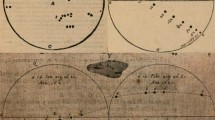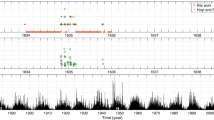Abstract
Sunspot records in the seventeenth century provide important information on the solar activity before the Maunder minimum, yielding reliable sunspot indices and the solar butterfly diagram. Galilei’s letters to Cardinal Francesco Barberini and Marcus Welser contain daily solar observations on 3 – 11 May, 2 June – 8 July, and 19 – 21 August 1612. These historical archives do not provide the time of observation, which results in uncertainty in the sunspot coordinates. To obtain them, we present a method that minimizes the discrepancy between the sunspot latitudes. We provide areas and heliographic coordinates of 82 sunspot groups. In contrast to Sheiner’s butterfly diagram, we found only one sunspot group near the Equator. This provides a higher reliability of Galilei’s drawings. Large sunspot groups are found to emerge at the same longitude in the northern hemisphere from 3 May to 21 August, which indicates an active longitude.














Similar content being viewed by others
References
Arlt, R.: 2008, Digitization of sunspot drawings by Staudacher in 1749 – 1796. Solar Phys. 247, 399. DOI . ADS .
Arlt, R.: 2009, The butterfly diagram in the eighteenth century. Solar Phys. 255, 143. DOI . ADS .
Arlt, R., Senthamizh Pavai, V., Schmiel, C., Spada, F.: 2016, Sunspot positions, areas, and group tilt angles for 1611 – 1631 from observations by Christoph Scheiner. Astron. Astrophys. 595, A104. DOI . ADS .
Biagioli, M.: 2006, Galileo’s Instruments of Credit: Telescopes, Images, Secrecy, Univ. of Chicago Press, Chicago. ADS .
Casas, R., Vaquero, J.M., Vazquez, M.: 2006, Solar rotation in the 17th century. Solar Phys. 234, 379. DOI . ADS .
Clette, F., Svalgaard, L., Vaquero, J.M., Cliver, E.W.: 2014, Revisiting the sunspot number. A 400-year perspective on the solar cycle. Space Sci. Rev. 186, 35. DOI . ADS .
Clette, F., Cliver, E.W., Lefèvre, L., Svalgaard, L., Vaquero, J.M.: 2015, Revision of the sunspot number(s). Space Weather 13, 529. DOI .
Drake, S.: 1957, Discoveries and Opinions of Galileo, Doubleday, Garden City. ADS .
Galilei, G.: 1613, Istoria E dimostrazioni intorno alle macchie solari E loro accidenti comprese in tre lettere scritte all’illvstrissimo signor Marco Velseri, Springer, Berlin. ADS .
Hoyt, D.V., Schatten, K.H.: 1998, Group sunspot numbers: A new solar activity reconstruction. Solar Phys. 179, 189. DOI . ADS .
McIntosh, P.S.: 1990, The classification of sunspot groups. Solar Phys. 125, 251. DOI . ADS .
Meadows, P.: 2002, The measurement of sunspot area. J. Br. Astron. Assoc. 112, 353. ADS .
Meeus, J.: 1991, Astronomical Algorithms, Willmann–Bell, Richmond. ADS .
Neuhäuser, R., Neuhäuser, D.L.: 2016, Sunspot numbers based on historic records in the 1610s: Early telescopic observations by Simon Marius and others. Astron. Nachr. 337, 581. DOI . ADS .
Reeves, E.: 2008, Galileo’s Glassworks: The Telescope and the Mirror, Harvard Univ. Press, Cambridge. ADS .
Sakurai, K.: 1980, The solar activity in the time of Galileo. J. Hist. Astron. 11, 164. ADS .
Svalgaard, L., Schatten, K.H.: 2016, Reconstruction of the sunspot group number: The backbone method. Solar Phys. 291, 2653. DOI . ADS .
Vaquero, J.M.: 2004, A forgotten naked-eye sunspot recorded by Galileo. Solar Phys. 223, 283. DOI . ADS .
Vaquero, J.M., Svalgaard, L., Carrasco, V.M.S., Clette, F., Lefèvre, L., Gallego, M.C., Arlt, R., Aparicio, A.J.P., Richard, J.-G., Howe, R.: 2016, A revised collection of sunspot group numbers. Solar Phys. 291, 3061. DOI . ADS .
Zolotova, N.V., Ponyavin, D.I.: 2016, How deep was the Maunder minimum? Solar Phys. 291, 2869. DOI . ADS .
Acknowledgements
We thank the referee for the substantial revision and helpful comments. The reported study was partially funded by RFBR according to the research projects 15-02-06959-a and 16-02-00300-a.
Author information
Authors and Affiliations
Corresponding author
Ethics declarations
Disclosure of Potential Conflicts of Interest
The authors declare that they have no conflicts of interest.
Electronic Supplementary Material
Below is the link to the electronic supplementary material.
Appendix
Appendix
Figures 15, 16, 17, 18, 19, and 20 show sunspots sorted into groups. Black rectangles with numbers denote individual sunspots or subgroups of sunspots. Green ovals mark sunspot groups. Note that “not a sunspot” shows paper defects. For convenience, blue and pink lines represent the \(x\)-and \(y\)-axes in the rectangular coordinate system, and the solar limb is shown as a red circle. Note that on 14 June, one tiny spot is missing in the image provided by the Galileo Project; this spot was added by us for completeness.
Rights and permissions
About this article
Cite this article
Vokhmyanin, M.V., Zolotova, N.V. Sunspot Positions and Areas from Observations by Galileo Galilei. Sol Phys 293, 31 (2018). https://doi.org/10.1007/s11207-018-1245-1
Received:
Accepted:
Published:
DOI: https://doi.org/10.1007/s11207-018-1245-1










